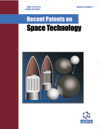- Home
- A-Z Publications
- Recent Patents on Space Technology
- Previous Issues
- Volume 3, Issue 2, 2013
Recent Patents on Space Technology - Volume 3, Issue 2, 2013
Volume 3, Issue 2, 2013
-
-
Use of Remote Sensing Techniques for Robust Detection and Estimations of Soil Organic Carbon: A Review
More LessSoil Organic Carbon (SOC) plays an important role in soil fertility, complex water and nutrient exchange processes in plant root zone, land degradation and global carbon cycle. Space technology is an efficient tool to: 1) estimate and map the SOC stocks and 2) rectify the stakeholders for enough food production and climate change management. Several studies and patents have reported complimentary results and su Read More
-
-
-
Towards Space ‘Vacuum Technology’ in Virtually Open Space: Ultra- Low-Pressure (ULP) Inflatable Structures
More LessEffective, self-sustaining ‘vacuum technologies’, such as magnetron-enhanced plasma deposition processes, may be realized in virtually open space separated from the cosmos by a flexible gas barrier inflated by the functional gas pressure required by those processes. The key challenging aspects of the design and functioning of Ultra-low-pressure (ULP) inflatable structures, as well as their structural integrity in space envir Read More
-
-
-
A Power Budget Model for Highly Adaptive Small Satellites
More LessAuthors: Sunday C. Ekpo and Danielle GeorgeSmall satellite power is a critical space segment resource that is at a premium. This is especially obvious when considering highly adaptive small satellites (HASSs) that exhibit static and active (dynamic) power regimes. Reconfigurable spacecraft modules and subsystems have been patented spanning core bus, payload, propulsion and deployment interface. The majority depends on static power margins for specific mission re Read More
-
-
-
Doppler Asymmetric Spatial Heterodyne (DASH) Light Detection and Ranging (LIDAR) Receiver
More LessAuthors: Christoph R. Englert, John M. Harlander and David E. SiskindThe Doppler Asymmetric Spatial Heterodyne (DASH) spectrometer concept was first proposed in 2006 for measuring Doppler shifts of single or multiple, near monochromatic signals and specifically for the passive measurement of atmospheric winds in planetary atmospheres. DASH interferometers have since been proposed, built and used for the passive remote sensing of Doppler shifts of naturally occurring, telluric Read More
-
-
-
Printed Thermoelectric Generator for Hybrid Tandem Photovoltaic/ Thermoelectric Device
More LessAuthors: Hyun Jung Kim, Jungmin Lee, Vijay K. Varadan and Sang H. ChoiAn analysis of the patented technology related to the use of conventional sources of energy is presented and the benefits offered by renewable energy systems are outlined. Current trends of patents on energy conversion technology show that the combination of two or more different forms of energy could surpass the limits of each individual conversion cycle. Photovoltaic solar cell tandem with thermoelectric generator is on Read More
-
-
-
The Possibility to Construct a Graser – High Sensitivity Gravitational Wave Detector by Using the Electrogravitic Property of Dielectric Materials
More LessAstronomers tried to detect gravitational waves, which are generated by the movement of massive astronomical bodies. However, it is very difficult to detect gravity waves by using conventional devices. Leon Brillouin proposed a concept of Graser, that is a powerful amplifying device for gravity waves, which can enable us to measure gravity waves, their frequencies, their velocities, and how they propagate. According to the the Read More
-
Volumes & issues
Most Read This Month
Article
content/journals/rptst
Journal
10
5
false
en


